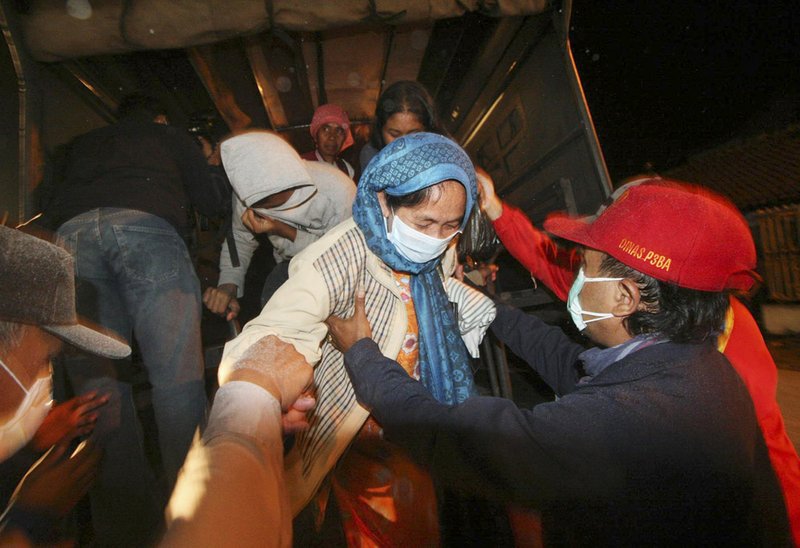MOUNT MERAPI, Indonesia — A volcanic eruption and a tsunami killed scores of people hundreds of miles apart in Indonesia - spasms from the Pacific “Ring of Fire,” which spawns disasters from deep within the earth.
Tuesday’s eruption of Mount Merapi killed at least 25 people, forced thousands to flee down its slopes and spewed burning ash and smoke high into the air on the island of Java.
Meanwhile, off the coast of Sumatra, about 800 miles west of the volcano, rescuers battled rough seas to reach Indonesia’s Mentawai islands, where a 10-foot tsunami triggered by an earthquake Monday night swept away hundreds of homes, killing at least 113 villagers, said Mujiharto of the Health Ministry’s crisis center. Up to 500 others are missing. Mujiharto, like many in Indonesia, uses only one name.
Disaster officials were preparing for the worst.
“We have 200 body bags on the way, just in case,” said Mujiharto.
The twin disasters happened hours apart in one of the most seismically active regions on the planet.
Interactive
http://www.arkansas…" onclick="window.open(this.href,'popup','height=650,width=750,scrollbars,resizable'); return false;">Earthquake causes, consequences
Scientists have warned that pressure building beneath Merapi’s lava dome could trigger its most powerful explosion in years.
But Gede Swantika, a government volcanologist, expressed hope the 9,737-foot mountain, which sent rocks and debris cascading down its southern slope, could be releasing steam slowly.
“It’s too early to know for sure,” he said, adding that a big blast could still be ahead. “But if it continues like this for a while, we are looking at a slow, long eruption.”
Eruptions at Merapi killed two people in 2006 and 60 in 1994. A 1930 blast killed 1,300.
After refusing to budge from the volcano’s fertile slopes, saying they wanted to tend to their crops and protect their homes, villagers started streaming by the thousands into makeshift emergency shelters late Tuesday. Many carried sleeping mats, bags of clothes and food as they settled in.
Officials said earlier that by closely monitoring the volcano 310 miles southeast of the capital of Jakarta, they thought they could avoid casualties. But the death toll rose quickly.
Police and volunteers were shown on Metro TV pulling at least 14 ash-covered bodies and carrying them to waiting vehicles.
Among the dead was a 2-month-old, said Mareta, a hospital worker who goes by only one name. The infant’s tiny body was draped in a sheet as his mother cried.
Three people at Panti Nugroho hospital died of burns after being hit by a searing cloud of ash, said Agustinus Parjo, a spokesman.
Even as they contended with the volcano - one of 129 to watch in the world’s largest archipelago - officials were trying to assess the effect of Monday night’s 7.7-magnitude earthquake off Sumatra that triggered the killer tsunami.
Indonesia is prone to earthquakes and volcanic activity because of its location on the so-called Pacific Ring of Fire - a series of fault lines stretching from the Western Hemisphere through Japan and Southeast Asia.
The quake, just 13 miles beneath the ocean floor, was followed by at least 14 aftershocks, the largest measuring 6.2, according to the U.S. Geological Survey.
The faults also caused the 2004 quake and Indian Ocean tsunami that killed 230,000 people in a dozen countries.
After Monday’s quake and tsunami, many panicked residents fled to high ground and were too afraid to return home.
That could account in part for the more than 500 people still missing, said Hendri Dori, a member of the parliament,adding, “We’re trying to stay hopeful.”
Hundreds of wooden and bamboo homes were washed away on the island of Pagai, with crops and roads flooded up to 600 yards inland. In Muntei Baru, a village on Silabu island, 80 percent of the houses were badly damaged.
With few relief workers able to get to the hardest-hit islands, reachable only by a 12-hour boat ride, fishermen searched for the living and dead. Corpses lay unburied because there was not enough outside help to dig graves, according to the Mentawai district chief, Edison Salelo Baja.
The island chain, 175 miles from Sumatra, has long been popular with surfers.
A group of Australians said they were on the back deck of their chartered boat, anchored in a bay, when the quake hit just before 10 p.m. Monday. It generated a wave that pushed their boat into a neighboring vessel. A fire soon ripped through their cabin.
“We threw whatever we could that floated - surfboards, fenders - then we jumped into the water,” Rick Hallet told Australia’s Nine Network. “Fortunately, most of us had something to hold on to ... and we just washed in the wetlands and scrambled up the highest trees that we could possibly find and sat up there for an hour and a half.”
Ade Edward, a disaster management agency official, said crews from several ships were still unaccounted for in the Indian Ocean.
The quake also jolted towns along Sumatra’s western coast - including Padang, which last year was hit by a 7.6-magnitude quake that killed more than 700. Mosques blared tsunami warnings over their loudspeakers.
“Everyone was running out of their houses,” said Sofyan Alawi, adding that the roads leading to surrounding hills were quickly jammed with thousands of cars and motorcycles.
“We kept looking back to see if a wave was coming,” said 28-year-old resident Ade Syahputra.
Information for this article was contributed by John Nedi, Niniek Karmini and Irwan Firdaus of The Associated Press.
Front Section, Pages 1 on 10/27/2010

